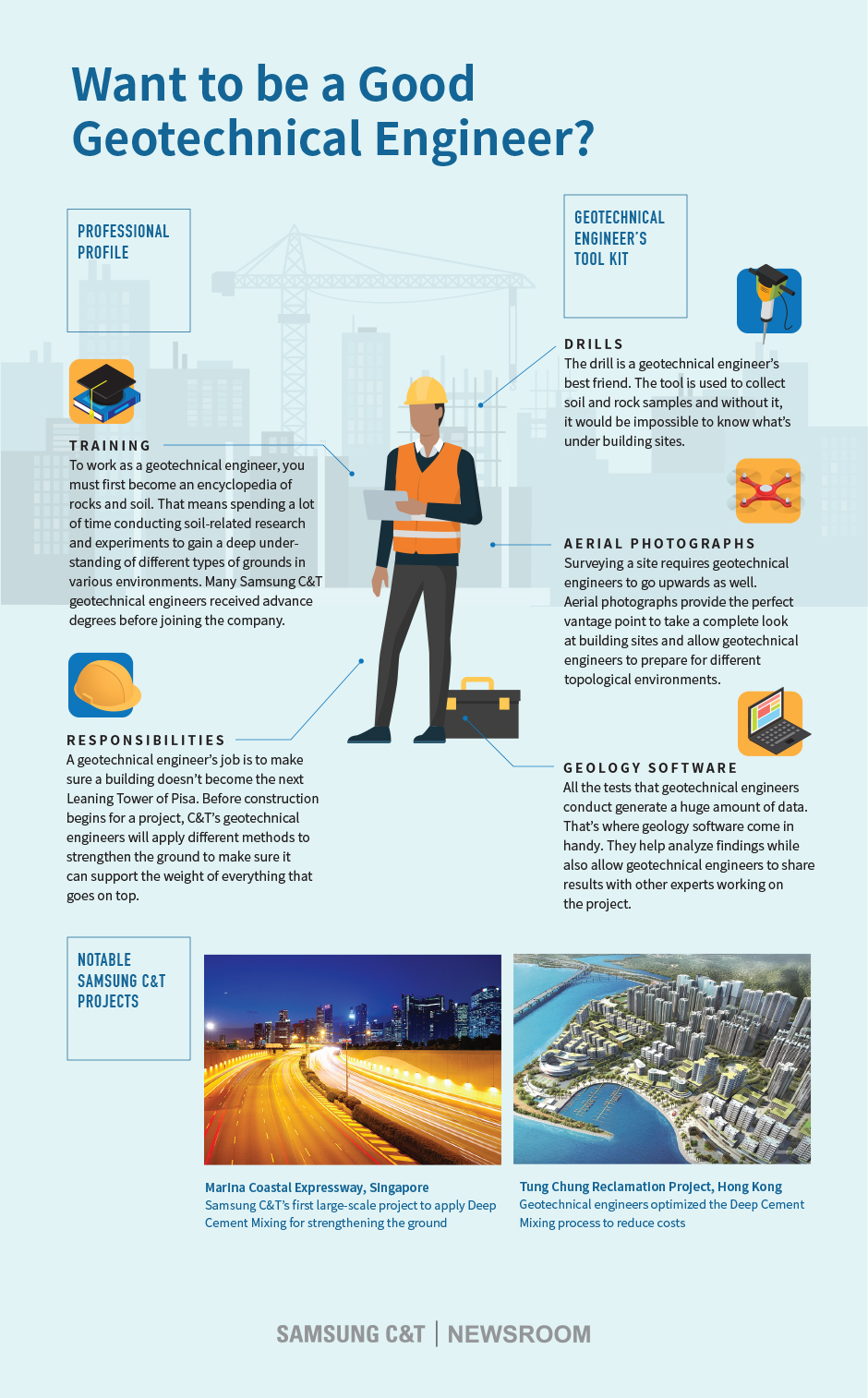The 6-Minute Rule for Geotheta
The 6-Minute Rule for Geotheta
Blog Article
Fascination About Geotheta
Table of ContentsWhat Does Geotheta Do?The Of GeothetaGeotheta Fundamentals ExplainedWhat Does Geotheta Do?Things about Geotheta

They perform site investigations, accumulate samples, carry out lab tests, and analyze data to examine the viability of the ground for construction jobs - Geo Tech Engineer. Based upon their searchings for, geotechnical engineers offer suggestions for structure style, incline security, preserving structures, and mitigation of geotechnical risks. They work together with various other specialists, such as engineers, architectural designers, and construction teams, to make sure that geotechnical factors to consider are incorporated right into the total job layout and execution
By analyzing the actions and residential properties of dirt and rock, they can determine potential geotechnical threats such as landslides, soil negotiation, or incline instability. Their knowledge helps avoid failures or accidents that could jeopardize lives and residential or commercial property. Below are some thorough responsibilities and obligations of a geotechnical engineer: Site Examination: Geotechnical designers conduct site investigations to collect information on subsurface conditions.
They analyze the information to understand the residential properties and actions of the dirt and rock, including their strength, permeability, compaction qualities, and groundwater conditions. Geotechnical Analysis and Style: Geotechnical engineers examine the data accumulated throughout website examinations to analyze the security and suitability of the website for construction projects. They execute geotechnical calculations and modeling to evaluate variables such as birthing capability, settlement, slope stability, lateral earth pressures, and groundwater circulation.
The 9-Second Trick For Geotheta
Structure Design: Geotechnical engineers play a vital function in making foundations that can securely support the intended structure. They analyze the dirt conditions and tons requirements to determine the ideal foundation kind, such as shallow foundations (e.g., grounds), deep foundations (e.g (https://www.easel.ly/browserEasel/14498559)., stacks), or specialized methods like soil improvement. They consider factors such as settlement limits, birthing capability, and soil-structure interaction to develop optimal structure layouts
They examine building plans, screen website activities, and conduct area examinations to confirm that the style recommendations are adhered to. If unanticipated geotechnical problems arise, they analyze the scenario and offer recommendations for removal or modifications to the design. Threat Evaluation and Reduction: Geotechnical engineers assess geotechnical dangers and risks related to the job site, such as landslides, liquefaction, or dirt disintegration.

Partnership and Interaction: Geotechnical designers work very closely with other professionals associated with a project, such as designers, architectural engineers, and construction groups. Effective communication and partnership are vital to incorporate geotechnical considerations into the overall project layout and building and construction procedure. Geotechnical designers give technological know-how, response queries, and ensure that geotechnical demands are satisfied.
The Buzz on Geotheta
Here are some types of geotechnical engineers: Structure Engineer: Foundation designers specialize in developing and assessing structures for frameworks. They analyze the look at this now dirt problems, tons needs, and site attributes to establish the most appropriate foundation type and style, such as shallow structures, deep foundations, or specialized methods like stack structures.
They review the variables affecting incline security, such as dirt buildings, groundwater problems, and incline geometry, and create approaches to avoid incline failings and minimize threats. Quake Designer: Quake designers focus on examining and creating frameworks to stand up to seismic forces. They evaluate the seismic risk of a site, evaluate dirt liquefaction possibility, and establish seismic design requirements to make sure the security and durability of structures throughout quakes.
They carry out field testing, collect examples, and examine the gathered data to identify the dirt properties, geologic developments, and groundwater conditions at a site. Geotechnical Instrumentation Designer: Geotechnical instrumentation engineers concentrate on surveillance and gauging the habits of dirt, rock, and frameworks. They install and keep instrumentation systems that keep an eye on elements such as dirt settlement, groundwater degrees, slope activities, and architectural displacements to assess efficiency and provide very early warnings of potential concerns.
Some Known Details About Geotheta
They carry out examinations such as triaxial tests, consolidation examinations, straight shear tests, and permeability examinations to collect data for geotechnical analysis and layout. Geosynthetics Engineer: Geosynthetics engineers focus on the style and application of geosynthetic materials, such as geotextiles, geogrids, and geomembranes. They use these products to boost soil stability, reinforce slopes, give drainage services, and control disintegration.
They often tend to be investigative individuals, which indicates they're intellectual, reflective, and curious. They are curious, methodical, reasonable, logical, and sensible. Some of them are also social, indicating they're kind, charitable, participating, person, caring, helpful, empathetic, tactful, and friendly. Does this noise like you? Take our cost-free job test to learn if geotechnical engineer is one of your leading career matches.
In the workplace setting, geotechnical engineers use specialized software program devices to do computations, produce designs, and assess information. They prepare records, evaluation project specifications, connect with customers and staff member, and coordinate task tasks. The office setup gives a favorable environment for study, analysis, and collaboration with various other experts involved in the task.
6 Easy Facts About Geotheta Shown
They often visit job sites to carry out website investigations, assess geotechnical conditions, and collect information for analysis. These visits include taking a trip to different areas, sometimes in remote or difficult surfaces. Geotechnical engineers might do dirt tasting, conduct tests, and display building and construction tasks to guarantee that the geotechnical elements of the task are being applied properly.
Geotechnical designers also operate in specialized geotechnical research laboratories. In these facilities, they carry out experiments, execute tests on soil and rock samples, and assess the design residential or commercial properties of the materials. Geotechnical research laboratory designers function extensively in these environments, managing screening tools, running instruments, and recording data. They work together with various other research laboratory staff to make sure precise and reliable screening results.
Report this page